|
Pennsylvania's State Parks and Forests: Looking Back to Move Ahead
Exploring Our Conservation Legacy
| |
Another Year Exploring Pennsylvania's State Parks & Forests

Do you recall that in our February issue, I mentioned that our theme for 2015 would be "Looking Back to Move Ahead - Exploring our Conservation Legacy?"
This time around, that legacy is our Lumber Heritage. And there are many issues and ideas that swirl around that concept. From a look at how our forests were devastated and rejuvenated to how they are managed today (on a large and small scale), the woods are a huge part of our landscape and our psyches. So let's take a look!
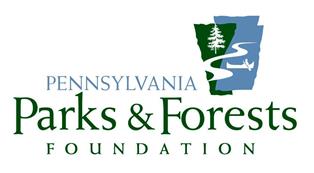
~ Pam Metzger, Membership Coordinator
Pennsylvania Parks & Forests Foundation
Explore Pennsylvania's Parks & Forests

Susquehannock State Forest
At 265,000 acres, the Susquehannock is the second largest bunch of trees in the state forest system. District Forester Chris Nicholas likes to point out that it truly is "the Big Woods" and his photograph in the masthead makes that pretty clear!
He says that if you study the picture (click the masthead for the larger version of the photo Chris shared), you might be able to make out where several timber sales have been completed in recent years. But, he says, "They are all greened back up and to me they tend to blend into the larger landscape now. The real message I am always promoting is that this is a 'working forest' providing environmental, economic, and social benefits to the citizens of the commonwealth every day. We have the largest timber management program of the 20 forest districts here - and we also have a lot of recreational opportunities, too!"
What does he mean when he says "a lot?" How about: the 85-mile Susquehannock Trail for hiking, 80 miles on the God’s Country Shared Use Trail for horseback riders, 140 miles of Billy Lewis Area Trails to keep the mountain bikers pedaling, the Denton Hill XC Ski Trail system (hike it, too), the 44-mile ATV trail, and 250 miles of groomed snowmobile trail to name but a few. Throw in seasonal hunting and fishing and there is barely a moment when you couldn't find something to do!
To explore lumber heritage (and the future of forestry management) in this part of the PA Wilds, the Susquehannock also offers the one-mile Cherry Springs Working Forest Interpretive Trail, a self-guided amble through the woods adjacent to and into Cherry Springs State Park.
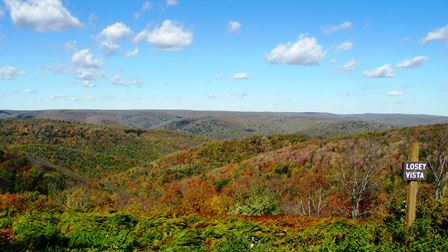
Chris is proud that all of this fun can take place in the Forest while "we are still able to provide a sustainable flow of high quality forest products, provide great scenery, provide a great variety of habitat for plants and animals, protect soils, and buffer hundreds of miles of streams and wetlands within the forest. Potter County has more miles of exceptional value streams than any other county in Pennsylvania."
Not to mention some pretty spectacular vistas. Click this one of Losey Vista (41o 45' 41.69" N, 77o, 45' 5.2" W) (also from DF Chris) for its larger version.
Explore Volunteerism

Pennsylvania Forest Fire Wardens
The job of protecting the 17 million acres of Pennsylvania woodland is, of course, a tremendous one. To accomplish it successfully requires a large and efficient organization of well trained, competent personnel dedicated to the preservation and protection of a great natural resource. The Forest Fire Protection Law, Act of June 3, 1915 formally established the Pennsylvania Forest Fire Warden organization for the protection of forests on all lands in the commonwealth. This protection organization is under the direction of the Chief Forest Fire Warden who heads up the Division of Forest Fire Protection in the Bureau of Forestry, Department of Conservation and Natural Resources.
Efforts to suppress wildfires in the early 1900s were a daunting task for the newly established forest fire warden organization. In 1913, the average fire in Pennsylvania burned 412 acres and consumed a total of 386,267 acres. Over 115 firetowers were built by 1925 and over 4,000 fire wardens and their crews were trained in suppression tactics to curtail these ravaging forest fires. By 1925, the average fire burnt only 49 acres and by 1945 only 62,000 acres burned annually. In 1960 the Bureau of Forestry began using aircraft to assist wardens and their crews controlling large fires across the state. One hundred years later, Pennsylvania averages 650 forest fires a year burning an average of 4,050 acres.
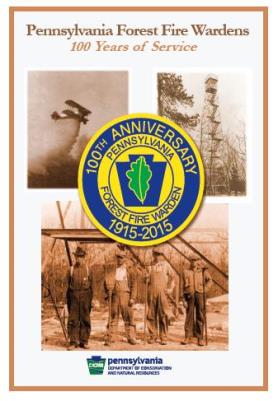 Ninety-eight percent of forest fires in Pennsylvania are caused by humans, so fire prevention became a big role in the fire warden’s job to reduce the damage caused by wildfires. The Wardens Helping in Prevention (WHIP) program was started in 1990 to support and recognize wardens for their prevention efforts. In 2013, the WHIP program was awarded the Bronze Smoky Bear award by the United States Forest Service for these efforts. Ninety-eight percent of forest fires in Pennsylvania are caused by humans, so fire prevention became a big role in the fire warden’s job to reduce the damage caused by wildfires. The Wardens Helping in Prevention (WHIP) program was started in 1990 to support and recognize wardens for their prevention efforts. In 2013, the WHIP program was awarded the Bronze Smoky Bear award by the United States Forest Service for these efforts.
Many things have changed over the last 100 years with improvements in transportation, communications, training, and organization, but the job of suppressing forest fires remains hazardous, dirty, and exhausting, requiring dedicated individuals. These men and women donate their time and energy to protect our natural resources for the benefit of all Pennsylvanians and deserve high praise from all who benefit from their efforts.
Governor Tom Wolf has proclaimed 2015 the Year of the Pennsylvania Forest Fire Warden and June 3, 2015 as Pennsylvania Forest Fire Warden Day. All forest districts will be celebrating our 100th anniversary at their annual forest fire warden training. On June 20, 2015 the Bureau of Forestry will celebrate at Hyner Run State Park with a picnic and guest speakers. For additional information and to find out how you can become one of us, visit the Bureau's website. And if you'd like additional information about the history of forest fire fighting and prevention, pay a visit to Pennsylvania's Forest Fire Museum open seasonally at Caledonia State Park.
~ Randy White, Chief Forest Fire Warden
Bureau of Forestry
Explore the Legacy

Pennsylvania Lumber Museum
"To collect, preserve and interpret the history of Pennsylvania's forests and forest industries and their role in the cultural and economic growth of the commonwealth and nation for citizens and visitors." Such is the mission of the Pennsylvania Lumber Museum, presently undergoing an extensive renovation and expansion in its lovely wooded setting along Route 6 in the Pennsylvania Wilds.
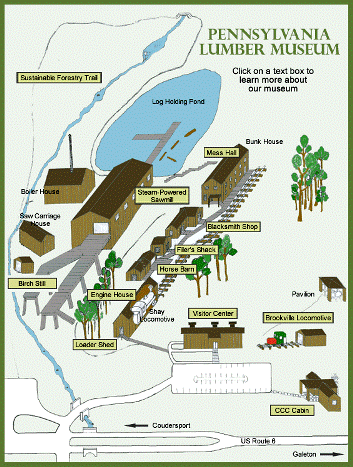
It's often been noted that it is hard to believe as you look out over one of Pennsylvania's magnificent vistas (like those DF Chris shared) that barely 100 years ago you would have seen quite a different view had you been standing in just the same place. The forests had been decimated and denuded in the face of a logging industry charged with supplying a seemingly limitless demand for timber as populations moved further west and industrialization took hold of our agrarian society.
But people were also beginning to understand what a permanent loss of our forests would mean - and NOT just in economic terms. People like Joseph Rothrock and the other members of the Pennsylvania Forestry Association knew it was imperative that we "preserve, protect and propagate forest." The future health of Penn's Woods required nothing less!
The photographs and exhibits at the Lumber Museum provide a fascinating opportunity to see just how far we've come and, it is hoped, ensure that we learned enough from the experience to never allow such a thing to occur again! Look for the Museum's grand reopening celebration to take place on May 15 and 16.
Details are still being worked out but the gallery showcase of the winning photographs from our 2014 Parks & Forests Thru the Seasons photo contest are slated to be on display at the Lumber Museum in April. Keep an eye on PPFF Up to the Minute on our website for confirmation of the dates.
Explore Campfire Recipe

Barbecue Beef & Biscuit Bake
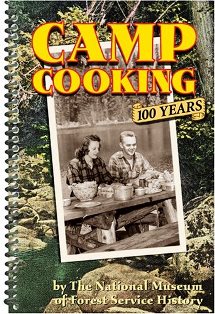 In December 2014, the National Museum of Forest Service History published Camp Cooking-100 Years. If anyone had the knack (and the incentive) for creative cooking in challenging circumstances, it would have to be the rangers of the US Forest Service and their devoted wives (historically). Throw in some beautiful photographs and anecdotes and you have a winner of a cookbook! (With meals you can make any time, any where. But why not a Dutch oven in the forest?) In December 2014, the National Museum of Forest Service History published Camp Cooking-100 Years. If anyone had the knack (and the incentive) for creative cooking in challenging circumstances, it would have to be the rangers of the US Forest Service and their devoted wives (historically). Throw in some beautiful photographs and anecdotes and you have a winner of a cookbook! (With meals you can make any time, any where. But why not a Dutch oven in the forest?)
Here's a casserole for a crowd!
3 lb ground beef
1 c ketchup
1 c barbecue sauce
1 c beef broth
1 1/2 tsp onion powder
1 1/2 tsp garlic powder
2 c sharp cheddar cheese, shredded
1 (7.5 ounce) package buttermilk biscuits
Heat a 12-inch Dutch oven over the coals. Brown ground beef and pour off the drippings. Add barbecue sauce and other seasonings. Cook 10 minutes or until steaming. Top with cheese and arrange biscuits on top of cheese.
Cover with lid and place 15 hot coals on top. Cook for 20 minutes or until biscuits are golden brown and cooked through. Serves 8.
Explore Trivia

Remember February? Yes, it was pretty darned cold - and we also asked about Ralph Brock's career as a forester in the early days of the 1900s. Before heading off to the forestry academy at Mont Alto, we asked in what state forest he was employed. Lots of people correctly answered Michaux State Forest. He did not stray too far when entering the academy.
Congratulations to Michael F. whose correct answer was drawn at random from all correct entries. For his trouble, he will receive a copy of our "light-hearted look at a necessary skill," Changing a Bike Tire: A Guide in Pictures. It's knowledge you need to have when mountain biking the wonderful trails and forest roads of the Michaux (or Susquehannock or any of the other forest districts where mountain biking is available).
This time out: The Pennsylvania State Forestry Academy (now PSU Mont Alto) trained students to fight wildfires and to regenerate the forests of Pennsylvania. Who was the first administrator at the academy and what was every freshman required to bring with him to the Academy?
Send your answer to Pam Metzger at the Foundation. All correct answers will be entered into a drawing for a copy of the latest printing of the Passport.
Explore the Green Life

Pennsylvania's Sustainable and Sustaining Forests
"Forest sustainability" is not simply a buzzword phrase of the moment, and in Pennsylvania we're justifiably proud of the fact that our state forests are annually certified by the Forest Stewardship Council (TM) as well-managed and sustainable. The FSC is "an independent organization supporting environmentally appropriate, socially beneficial and economically viable management of the world's forests." A lot of effort goes into maintaining that certification and why it's important fills pages of the FSC website. And if you thought forestry was just about watching a bunch of trees grow, Google "state forest resource management plan dcnr 2015" and read just how complex and complete each forest district's planning has to be for each year.
According to Allyson Muth, Forest Stewardship Program Associate at Penn State's Department of Ecosystem Science and Management, "The snow came down in droves on Friday morning, March 20. Wasn’t this the first day of spring? Nevertheless over 150 hearty forest landowners and people who care about the woods came prepared for excursions to a paper mill, a lumber mill, a hunting camp, a property owned and cared for by The Nature Conservancy, or Canoe Creek State Park. The reward for braving the snow and cold was a unique opportunity to learn first-hand about wood products, active management to improve forest stewardship, Pennsylvania’s wood history, or birds and bats.These educational tours were the first events of the 2015 Forest Landowners Conference: The Future of Penn’s Woods, held March 20 and 21 at the Blair County Convention Center in Altoona. The event, sponsored by the Center for Private Forests at Penn State and its partners, was the second biennial conference organized for landowners and others interested in the care and stewardship of the woods."
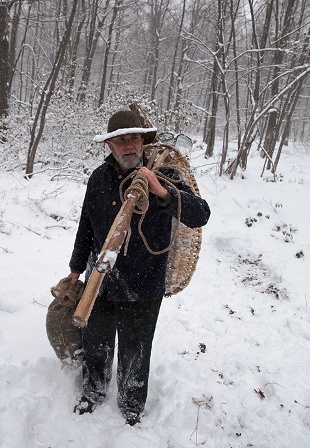 Attendees also enjoyed presentations by Center Director and Ibberson Professor of Forest Management Dr. Jim Finley, naturalist Chuck Fergus, and occasional re-enactor and Penn State Extension Specialist Sandy Smith (pictured here in a photo by Michael Houtz of the PSU College of Agricultural Sciences) who shared the history of charcoal making and iron furnaces in 19th century Penn's Woods. Attendees also enjoyed presentations by Center Director and Ibberson Professor of Forest Management Dr. Jim Finley, naturalist Chuck Fergus, and occasional re-enactor and Penn State Extension Specialist Sandy Smith (pictured here in a photo by Michael Houtz of the PSU College of Agricultural Sciences) who shared the history of charcoal making and iron furnaces in 19th century Penn's Woods.
Visit the Center's website to sign up for the PSU electronic newsletter Forest Leaves;and receive additional information on the conference (and when it comes around again in 2017) as well as other issues of importance to forest landowners, large and small. Women landowners? Your chance for a special workshop comes up at the end of April (25 and 26) at Grey Towers in Milford with Women & Their Woods.
When it comes to preserving the legacy of our forests, it's hard to imagine an issue more pressing than the preservation of our state tree, the Eastern Hemlock. Its threat by the invasive woolly adelgid is frustrating to the professionals in charge of managing our state forests and to private landowners as well, and downright heart-breaking to those of us who are inexplicably moved by the sight of these sometimes fragile-appearing giants. At the end of 2014, DCNR released its Hemlock Conservation Plan outlining the threats to the species (the adelgid being, sadly, only one) and a prioritization of planned attacks. We can only wish them well - and note that the freshly-rejuvenated Friends of Cook Forest (a PPFF chapter) have made raising dollars to assist in the attack their core mission.
Explore PPFF and our Programs

It's back! We ran out of copies of the Pennsylvania State Parks & State Forests Passport (a sure sign of a winning publication) but it's back in stock and available for purchase on our website. More good news? There's been no price increase - $14 covers the book, tax, shipping and handling. Order now!

A little housekeeping is needed. We are exploring our options with respect to creation of future issues of EXPLORE. In order to satisfy the requirements of the Anti-Spam Overseers, we need to confirm the validity of our email lists. PLEASE, if you wish to continue to receive Explore (and/or our weekly eblast, Take Five/Fridays with Pam), CLICK THIS LINK and confirm your all important OPT-IN. We would HATE to lose track of you in any transition!
Thank you!
Explore comes to you courtesy of the Pennsylvania Parks & Forests Foundation
1845 Market Street | Suite 202 | Camp Hill, PA 17011 | 717.236.7644
Content about Pennsylvania's conservation history provided through the support of a grant from the Heinz Endowments.
|
| |
|
|
|
Email Marketing By
|


|
|
|
|